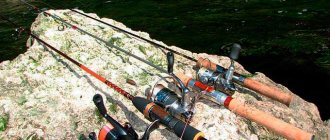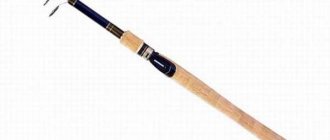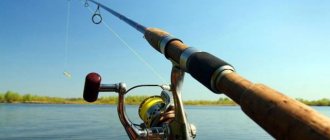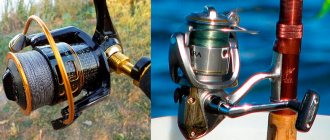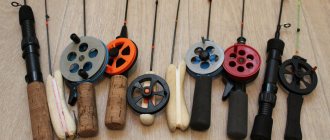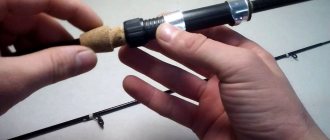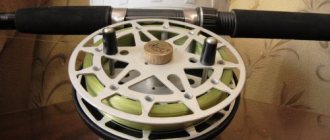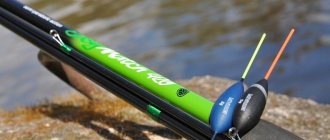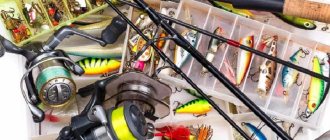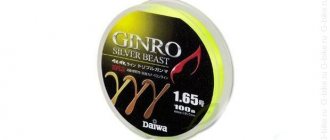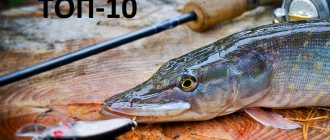The question of how a spinning rod differs from a fishing rod is often asked by green beginners who decide to take up fishing. For a more or less experienced fisherman, all the differences are obvious. Therefore, this material will be useful, first of all, to novice fishermen.
Anyone who is going to devote themselves to fishing for a long time and seriously should know the difference between a spinning rod and a fishing rod, since soon they will have to choose gear and appropriate hunting methods for a specific type of fish and fishing conditions in the chosen body of water.
Fishing rod as a means of fishing
According to historians and fishing researchers, the prototype of the fishing rod appeared in time immemorial in the ancient world, when man began hunting fish. With its help, food was actually obtained, and the fishing profession was equated to hunting and was highly revered. Of course, since then the float rod itself has undergone many modifications and improvements. For example, flexible tree branches were previously used as fishing rods, then bamboo, then plastic. And the rod became extendable, the fishing line was threaded into convenient rings. But the fact remains: its main functions remained, in principle, the same as many centuries ago. What is the difference between a fishing rod and a spinning rod, what is the difference between these two tackles? Let's figure it out.
A selection of spinning equipment elements
Both an experienced angler and a beginner can fish with a spinning rod. Only, unlike beginners, old-timers know that if you choose the wrong equipment, spinning fishing will a priori be unsuccessful. Let us outline the points that are worth paying attention to.
Spinning test
A spinning test is a number that shows how much weight a rod can support. The first number is the minimum, the second is the maximum. Based on these limits, one can judge its power and how productive and safe fishing will be in general.
Classification of fishing rods by class:
- Light (Light/ L) from 7 to 15 grams. Sensitive spinning rods designed for catching small fish. The length of such rods usually does not exceed 2 meters;
- Medium (Medium/M) from 15 to 30 grams. The weight of the bait increases, the length of the rod is already up to 3.5 meters. With this class you can fish in large, deep rivers;
- Heavy (Heavy/H) from 20 - 60 grams. Suitable for sea hunting.
There are also intermediate classes:
- Ultra light (Ultra Ligh/UL) from 5 to 10 grams;
- Medium Light/ML from 5 to 20 grams
- Medium Heavy/MH from 10 to 45 grams;
- Extra Heavy (EH,HX) from 60 to 250 grams.
It is very important to remember that the test limits cannot be exceeded!
Spinning rod length

When choosing the length of the rod, focus on the following factors:
- Conditions and place of fishing. If you are going to fish in places where there is no need or it is impossible to cast long distances, choose a rod no more than 2 meters. Such situations include fishing from a boat or on an overgrown river bank.
- Style. Each style will require a specific rod length. For the jig style, it should not be less than 3 meters. For “twitching” no more than 2.5 meters.
- The size of the reservoir. It is logical that for large water areas and wide rivers you need to use long forms and vice versa.
Spinning rod structure
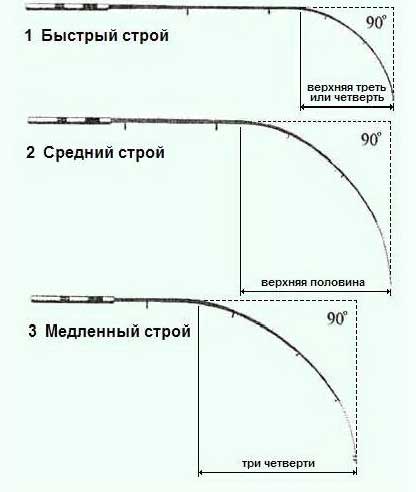
The nature of the bending of the blank when casting and fishing for prey is called the structure of the spinning rod. You can determine the action by the nature of the bend of the rod by hanging a certain weight from its tip. There are three types of construction:
- Fast. — The most sensitive system to bite. Allows you to make aggressive hooks, soft and sharp jerks with the end of the rod (twitching). If, when swinging, a smooth bend begins in the last third of the rod, this is a fast action.
- Average. — The most suitable option for pioneers. Allows the use of uniform and twitch wiring; When swinging, the upper part of the rod slowly recovers to its original position and bends from the middle.
- Slow. — Build suitable for long casts. Softens fish jerks. Bending when rocking along the entire length.
Spinning rod handle
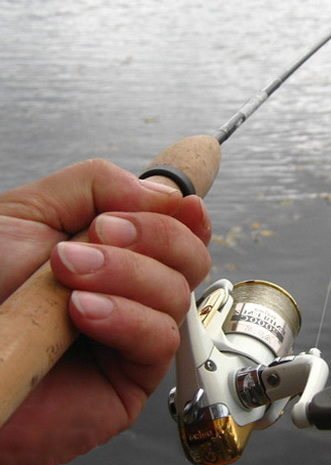
The shape of the handle should be as comfortable as possible for the fisherman;
- Nothing should interfere with a strong hand grip;
- The handle covering should be made of a material that will not cool your hand and slip out. For example, rubber or leather.
- You must decide how you will cast. If you use one hand, then the handle should be short, and vice versa if you use two hands.
Spinning reel
One of the main differences between a spinning rod and a fishing rod is the presence of a reel on the rod. The success of the entire process depends on her choice. The reel is a key element of equipment; without it, spinning fishing is not possible. With its help, they fish out the caught fish, move and cast the bait, and store the fishing line. Every angler must remember not to allow the reel to come into contact with water and sand. There are three types to choose from:
- Inertia coil. -Today, he has lost his
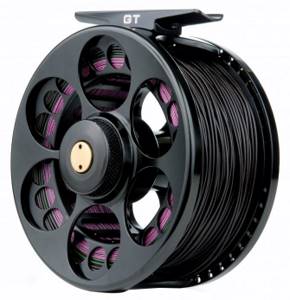
popularity kind. The fishing line is fixed with your fingers while retrieving, thereby ensuring control over the bite. - Inertia-free reel. - Allows you to fish with
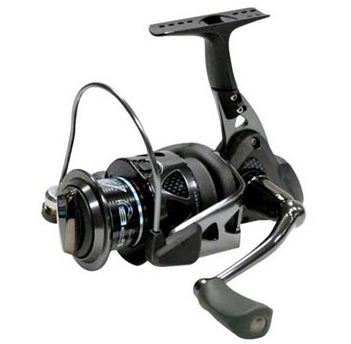
using the thinnest lines of small baits and vice versa. The most popular type today. - Multiplier reel. -Used for fishing

lures such as wobblers, jigs, trolling. They have an average degree of popularity.
Since the inertia-free reel is one of the most popular, we will consider the main points that you need to pay attention to when choosing it.
- Size. — An indicator that affects power. When catching small fish, a reel size 1000-2500 is suitable. Size 3000-5000 is used to increase the parameters for a larger spinning rod, larger bait and larger fish.
- Timber capacity. — It is marked on the spool and makes it clear how many meters of fishing line the spool can hold.
- Bearings. — Must be located in the line roller. The main task of bearings is to ensure smooth and easy running of the reel. The presence of bearings increases the service life of elements in contact with each other.
- Line laying. - Cross-spooling is best, but less line is spooled this style. You can increase the amount of fishing line by winding it straight. But this method is problematic because the turns can mix with each other.
- Friction brake. — There are two types of friction brakes: rear and front. Fishermen use the front brake more willingly; unlike the rear brake, it does not weigh down the reel. The disadvantage is that it is inconvenient to adjust when fishing.
When buying a reel in a store, be sure to pay attention to its appearance; there should be no external damage. The spool should be smooth, without chips or burrs. Also check the line roller; it should not move too easily from one position to another.
Line and leash
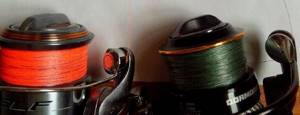
The choice of fishing line for a spinning rod is a personal matter for each fisherman and an eternal topic of debate. There are two options to choose from, monofilament line or as it is also called monofilament and braided cord. Let's look at the features of each.
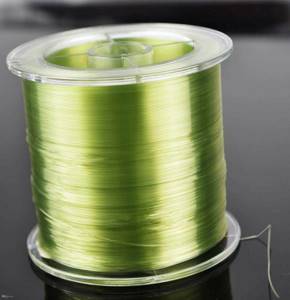
- Monofilament line. -Less popular than wicker. Made from strong and durable materials. It is practically invisible in water and has great stretchability, which is not always appropriate. It has “memory” and is ideal for use by beginners.
- Braided cord. —
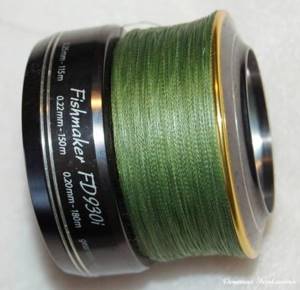
The price is significantly higher than the cost of monofilament. Withstands heavy loads. Properties such as memory and stretchability are completely absent. To handle this type of fishing line you will need experience and skill.
To catch a predator, you must install a leash on the rod. It is best to use flexible leashes no longer than 20 centimeters. Wire ones are used much less frequently, mainly for pike fishing.
Lures
Another difference between a spinning rod and a float rod, as already mentioned, is the use of artificial baits. Today there is a huge selection of spinning baits. Let's look at the types of baits and what kind of catch you can expect when using them.
- Wobblers. — A universal type of bait. Wobblers are produced in the form of fry from plastic or foam, wood. There is a blade in the nose of this type of bait; it forces the wobbler to dive when retrieved. There are also two types of wobblers that do not have blades. The first, Rattlin, is used for fishing on the bottom. They are made in the shape of a fish with a rattle inside. Pike perch, catfish and perch cannot swim past such bait. The second, Popper, is an exclusively surface type of bait. As already mentioned, they do not have a blade; instead, a depression is created, which creates gurgling noise when inserted. This is of great interest to local pikes.
- Spinnerbaits. — The most popular type of bait that does not get stuck or snagged in thick algae. In the fishing world they are called “unhooked”. The bait is designed in such a way that it irritates all the senses of the fish.
- Silicone baits. — These are vibrotails, twisters, worms or squids. Pike, catfish and perch bite well on this type of bait. They are used together with a sinker for hunting in the bottom zone.
- Foam fish. — The most touching type of bait, due to the material from which it is made, the appearance of a sick fish is created. Such a fish swims with its tail up, which cannot be ignored by cruel bershi, catfish, perches and pikes.
- Spoons. — This type of bait can be divided into the following types: Oscillating. A concave plate, which with its movements in the water very much attracts pikes;
- Rotating. They begin their movement during wiring from the resistance of water. Perch bite best on them;
- Castmasters. They have their own specific game, but in essence it is the same swing. They are the longest-range spinners and favorites of asps;
- Devons. They have a propeller and require quick wiring. Heavy and long-range lures that catch perches and asps.
Spinning fishing
It is believed that this tackle revealed itself to the world in England. By the way, at first the fishermen there cast a spinning rod into the line without the help of reels. The fishing line was simply pulled together by the fisherman and folded, for example, between the legs. And when casting, it passed through the rings, rising from the ground. In general, the spinning rod was more like a float fishing rod, but with a long, very long line. Coils began to be included in the design only in the 19th century. With the invention of the inertial reel, working with a spinning rod became much easier, and it became a more popular piece of equipment. And when inertialess reels began to be installed in the 20th century, fishing became elementary, although it still required certain skills from the fisherman. So, more specifically: what is the difference between a spinning rod and a fishing rod? After all, modern fishing rods can also be equipped with reels with fishing line and fold out telescopically. In particular, fishing neophytes who cannot accurately understand this issue may encounter problems of this kind.
Which spinning rod test should you choose?
Those who are not keen on fishing will not notice the difference between fishing rods and spinning rods and will not explain the methods of fishing with them.
Fans of using a fishing rod claim that its advantage is that it catches more fish in a certain time than using a spinning rod.
Spinners argue in response that only a spinning rod can take a heavy catch, and the fishing process itself is more exciting.
Although these debates have been going on for a long time, each of them is right in their own way.
The float rod has always been popular. Even spinners once began their fishing journey by using it.
Its use has a number of undeniable advantages:
- Convenience. This quality has already been noted by beginners and professional fishermen.
- The ability to use it in any weather conditions and seasons, except winter.
- Versatility. It is possible to catch any type of fish: different in size and method of feeding.
- A simple way to catch.
- Better bait control.
- Affordable price.
- It is easy to comprehend the secrets of fish science.
Fishermen who use it have developed such qualities as patience, perseverance, the ability to remain silent for a long time, and the ability to competently use camouflage.
But spinning over a fishing rod also has a number of advantages:
- Possibility of catching large predatory fish.
- Spinning fishing is an active form of fishing. While fishing, the fisherman has to constantly change his location.
- It has a specially designed handle that provides a comfortable grip and the ability to attach a reel.
- Large selection of additional accessories.
- The casting range is much greater.
- An advantage when working with large baits.
How to catch more fish?
I have been active fishing for quite some time and have found many ways to improve the bite. And here are the most effective:
- Bite activator. Attracts fish in cold and warm water with the help of pheromones included in the composition and stimulates its appetite. It’s a pity that Rosprirodnadzor wants to impose a ban on its sale.
- More sensitive gear. Reviews and instructions for other types of gear can be found on the pages of my website.
- Lures using pheromones.
You can get the rest of the secrets of successful fishing for free by reading my other materials on the site.
Fishing will be successful if you choose the right fishing method and fishing rod. Among the huge number of devices for catching fish, spinning rods and float rods have been and remain in demand.
The main feature of these gears is the type of prey and the method of catching it.
We invite you to read: Rent a cottage on Akhtuba for fishing - accommodation in comfortable cottages at the fishing base "Fisherman's Pier" in the Astrakhan region
Fishing rods
The fishing rod can with great confidence be called a universal tackle, since it is used on any body of water, with or without current, in deep places and in shallow water.
- Used for fishing in one place (on the shore or from a boat), without making long casts.
- Suitable for different types of fish.
- Regardless of the fishing location, the method is always the same: the bait is thrown to the required depth, and the bite is determined by the behavior of the float. Then you just need to pull out the catch correctly.
- It is not difficult to choose a nozzle for the tackle; its choice is not limited and any will do: worms, small fish, bread, larvae.
- The cast should be performed with a smooth movement (away from you without jerking), holding the line.
- There is no need to rush into hooking because each fish bites differently. It is performed with a quick, but not sudden movement.
Spinning
Spinning fishing is suitable for those fishermen who do not like quiet fishing and who cannot see themselves without movement.
With the ability to handle tackle, knowledge of the characteristics of fish, with a skillful combination of the type of bait and fishing location, you can achieve an excellent catch. You can fish with it in any reservoir with different currents.
The main feature of fishing with this gear is the method of placing the bait. She must lure a predator with her play in the water, and the fisherman creates this play with the movement of the rod and fishing line.
- Having a moving bait in its design, a spinning rod is perfect for catching predatory fish, which lasts from spring to autumn.
- Due to the complex fishing technique, using a spinning rod requires skill and experience.
- It is used only for catching predatory fish, and the spoon is cast over a fairly large distance.
- The time interval between the spoon hitting the water and the start of reeling always depends on the depth of the reservoir and the mass of the spoon (but does not exceed 5 seconds). The heavier the spoon, the faster it will sink into the water.
- The most attractive places for catching large fish are considered to be deep reservoirs, places with algae, where there are snags, and flooded bushes. In such places fish are present almost until late autumn.
- For a good catch, you need to look out for those places where small fish live, since there you can catch a large predator.
- In summer, the best depth is considered to be up to 2.5 m; in spring and autumn, the depth increases.
It will be possible to make a choice in favor of one of the gears only when each of them is tested while fishing.
Only based on your feeling from the fishing process, on how convenient it was to use them, can you give preference to a fishing rod or spinning rod.
If you plan to fish from the shore or boat on small and medium-sized rivers, canals, ponds and lakes (width about 120 m), then I advise you to choose a spinning rod length within 2.1-2.7 meters. I advise you to choose a spinning rod with a length of 2.7 or more meters for those who are going to fish from the shore on large rivers, with deep holes, on large lakes and reservoirs - if necessary, long casts, about 100 meters or more.
The test is a spinning indicator that determines the lower and upper weight limits of the artificial baits used. When choosing a spinning rod, you need to decide what weight the artificial bait you will use when fishing will be. The lower test is the minimum value of the mass of the bait. In simple terms, if the weight of the bait is equal to the value of the lower test, then when retrieving such a bait you will feel its play with the rod, and if the weight of the bait is less than the value of the lower test, then when retrieving, you will not feel the play of the bait with the spinning rod.
The lure test (or just test for short) is the most important characteristic of a fishing rod. Shows the weight range within which the baits used must fit. The upper limit of the test is the permissible weight limit, systematically exceeding which, sooner or later you will break the rod. The lower limit is the minimum weight of the spinner (or jig head, or wobbler), which is able to load the spinning rod so that it “works” and, roughly speaking, serves as a “catapult” when casting. However, remember that the manufacturer does not always honestly, to the nearest gram, indicate the test of the rod, especially the lower one.
For example, a test of 1-5 grams means that the spinning rod is “sharpened” for the lightest baits. However, this does not make it impossible to catch large fish with it. It will just take longer to fish it out, and a well-tuned friction brake of the reel will help to avoid breakage during strong jerks.
The upper value of the test is the maximum weight of the bait that can be cast with this rod without the risk of breaking it. In terms of the weight of spinning rods used for casting baits, there are ultra-light ones, with a dough of 1-5 g, light 5-15 g, medium 7-25 g, heavy 20 or more grams, but this is all approximately. There are such rods on which, instead of a test, a range of recommended fishing lines for breaking load is printed.
For catching small and medium-sized fish, as well as for the thrill of fishing, I recommend a spin with a dough of 0-10 g. My personal opinion is that this is a bit of overindulgence. In addition, such a fishing rod requires delicate care. For catching medium-sized fish on small rivers and lakes, a rod with a test weight of 5-25 g is suitable.
We suggest you familiarize yourself with: Trout for spinning
In ancient times, the profession of fisherman and hunter was held in high esteem. When fishing was one of the main means of subsistence, the fishing rod became an integral part of fishermen’s equipment. A lot of time has passed since the appearance of the first fishing rod until today, and the fishing rod has undergone many modifications and design features.
The main change was the use of other materials - in ancient times people used tree branches, then they began to use bamboo fishing rods, and now they use plastic fishing rods with reels. And the winding rings and telescopic structure of the fishing rod appeared not so long ago.
But the main thing remained unchanged - the fishing rod was, is and will be used by people for only one purpose: catching fish. True, sometimes flags are hung on them at rallies, but this is a side effect. All that remains is to figure out how a fishing rod differs from a spinning rod and what the fundamental features of this gear are.
Advantages of a fishing rod
The high popularity of float rods was not achieved without reason. Almost all novice fishermen learn to fish with a float rod, and only later move on to feeder or spinning gear. There are many advantages of float rods:
- ease of use in hard-to-reach places on the pond;
- versatility - with the right equipment, it is suitable for catching predatory and peaceful fish;
- ease of bait control;
- low price;
- ease of operation;
- develops patience and perseverance in the fisherman;
- helps to master various camouflage methods.
It is generally accepted that spinning was first invented and used for fishing in England. It is noteworthy that the first spinning rods did not include a reel in their design. The fishermen pulled the line together with their hands and put it in a pile. During casting, it was lifted from the ground and passed through the winding rings.
Structurally, the spinning rod was very similar to the float rod, and the only difference was the long fishing line. But after a certain time, reels began to be included in the design of the spinning rod. Spinning rods gained massive popularity as soon as fishermen came up with an inertia-free reel, which significantly simplified the fishing process.
With the advent of reels, fishing has become convenient even for beginners, although spinning fishing still requires the fisherman to have certain skills. Many of you are already tired of reading and want to hear a specific answer to the question of how a spinning rod differs from a fishing rod.
Rod
For most float rods, it is made of plastic, can reach up to five meters and has a weight category of about 200 grams. As a rule, according to the type of assembly - plug-in or telescopic, sliding. A spinning rod is shorter, no more than 3 meters long, but for fishing from a boat, a 2-meter device will be sufficient. It also bends very well, due to the fact that it is made of carbon fiber or carbon fiber. The rod is also equipped with a comfortable handle, comparable to the handle of an excellent sword. The handle makes it possible not to get tired of your hands during multiple casts associated with the specifics of spinning fishing. The reel also adapts to it using a special mount.
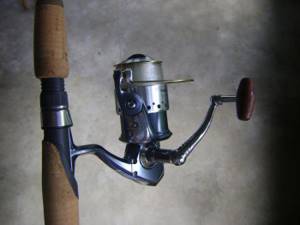
Features of the fishing rod
When people talk about a fishing rod, they often mean classic fly fishing tackle with blind rigging. It has been familiar to everyone since childhood and is the one with which they begin to take their first steps in fishing, catching bleak, small roach, ruff, perch and crucian carp off the shore.
The fishing rod is a “pole” from 2 to 6, and sometimes up to 15–18 meters long, equipped with a fishing line and equipment consisting of a float, weight and hook. There are different options for this gear:
- The flywheel with blind equipment is the most common and is used everywhere at depths from 0.5 to 4 meters. Used short from shore or boat.
- Flywheel with sliding equipment - the difference with the first one lies in the equipment. The float moves freely along the line, depending on the depth at the fishing site.
- The Bolognese fishing rod is equipped with a lightweight inertial wire reel, which allows you to fuse equipment or adjust the length of the fishing line.
- Match or long-casting tackle is specially designed for hunting at a great distance from the shore.
- Plug fishing rod – has a length of up to 18 meters, designed for sport fishing from the shore. Allows you to pinpoint fish the selected fishing zone.
Modern fishing rods are made from polymers. Budget products are made from fiberglass, mid-price ones are made from composite material, and expensive ones are made from carbon fiber. Previously, this tackle was made from bamboo or walnut rods, but today such a rarity can be found somewhere in the outback.
On a note! For infrequent fishing, it is enough to buy a telescopic fiberglass rod up to 5 meters long.
Most fishing rods are telescopic. Their main advantage is compactness. The instrument, up to 8 meters tall, when folded, is only 50–80 cm long and weighs up to 300 grams. Therefore, telescopes are most in demand among fishermen.
Plug-in float rods stand apart. The sports version is a long model consisting of a butt and a whale. The first part may have several elbows, allowing them to be increased to the required size. The second one represents the top of the rod. It comes in one, two or several sections.
Forests
It is used in both gears. When choosing it, you should also take into account what kind of prey you want to catch (size, character, habitat). The forest is made from nylon, nylon, anide, and other synthetic materials. They are divided into two types: mono and wicker. In spinning rods, when catching large predators, braid is often used. The rest is up to the fisherman’s preference.
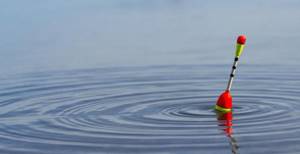
The most important characteristics of a spinning rod
When purchasing a spinning rod, you should consider its structure. It comes in fast, medium and slow. This parameter shows how the spinning rod bends under load. With a fast action, only the upper part of the spinning rod bends. When slow, the spinning rod bends evenly almost from the handle itself. A spinning rod with a medium action has intermediate characteristics.
Another important characteristic of a spinning rod is its lure test. For example, test 1-5 indicates that the spinning rod can work with the lightest baits from 1 to 5 grams. Spinning rod with 5-25 test can be called universal; it is suitable for a wide range of baits.
Build and test are also typical for fishing rods; manufacturers always indicate these parameters in their description.
Hook, sinker, bait
In fishing rods with floats, to quickly immerse the bait in the water, a lead sinker is usually used, and the fish bait is put on a hook. In a spinning rod, the functions of a hook, bait and sinker are combined. Currently, there are a great variety of spinning baits of various shapes and sizes, allowing you to catch almost any type of predatory fish.
Now you know how a spinning rod and a float rod can differ. We hope that this information, set out in general terms, will help even an inexperienced beginner in fishing to understand the choice of gear. Happy fishing to you!
Converting a spinning rod to a fishing rod
Sometimes a fisherman needs to adapt his spinning tackle to a fishing rod. This happens when a predator completely refuses to attack the offered bait, but nearby colleagues successfully catch a large roach or a well-fed crucian carp.
From a spinning rod you can always make a fishing rod for long-distance casting, which, although it will be inferior to a real match, will allow you to catch fish. For this you will need:
- float with a carrying capacity of 4–5 grams;
- monofilament line for a leash;
- a set of lead weights;
- single hook of the required size.
We fix the float on the main line. We tie a monofilament leash with a diameter of 0.12 to 0.20 mm and a length of 30–80 cm to the free end of the cord. We equip the tackle with the required amount of weights and attach a single hook, the size of which is selected for the bait used and the potential weight of the prey.
Origin story
Nowadays, fishing for people is more of a great pastime than a way to get food. But previously this was one of the most common and affordable options to feed the whole family. It was the need for food that prompted people to invent a device for catching prey in water.
Fishing rod
The prototype of the float rod appeared during the time of the first people who used it to obtain food. Over the years it has undergone many improvements. The instrument became lighter and more functional each time. However, the basic design features of the fishing rod have not changed over time.
The gear primarily includes a rod with a length of 2.5 to 5.50 meters.
Of course, there are longer models, but they are extremely rare. The first people used wood to create such gear, but over time they switched to plastic and bamboo, since these materials are lighter and more durable.
Spinning
This tackle appeared in the UK. At first, the British cast without the help of a reel; the fisherman pulled the line and laid it at his feet. When casting the rod, it rose from the ground and went through the rings.
Initially, spinning had nothing in common with modern models. Rather, it looked more like a float rod with a long line.
Only at the beginning of the 19th century did they begin to install a reel on this tackle. Casting was still done manually, but fishing was much easier.
Then, over time, the reel became inertial, it was easier to work with it, but, nevertheless, it required special skills and experience for successful casting.
Only with the beginning of the nineties of the twentieth century did anglers have inertia-free versions of reels; they allowed long-distance casting of bait, and fishing became an elementary thing.
Spinning
Is the difference between a spinning rod and a feeder really that significant?
Both of these rods are characterized by the following indicators: test, action, length. We talked about these indicators in the article “How to properly organize spinning fishing for predatory fish.” If we briefly decipher these indicators, the form test indicates the maximum loading weight of the gear, the action indicates the ability to bend under the influence of load, the length of the rod directly affects the delivery distance of the bait.
The first thing that distinguishes a spinning rod from a feeder rod is its length – it is somewhat shorter. Spinning fishing is more active, so casting bait should be more comfortable both from the shore and from the boat. During one fishing trip, the form has to be rethrown hundreds of times; therefore, special attention is paid to the lightness of the gear.
Another factor that distinguishes a feeder from a spinning rod is that the feeder rod is equipped with replaceable tips, the so-called quivertips. They do not participate in casting the tackle and serve as a bite alarm. Spinning tackle does not use a similar design; the bite is felt by the angler’s brush.
The tips are divided according to the degree of sensitivity:
- For fishing in still water or in light currents, soft tips are used;
- medium ones are used for faster water movement or strong wind;
- a significant current forces you to set up the tackle with rigid quivertips.
Both types of fishing rods are currently made from the same components: fiberglass, carbon fiber, composite materials. The most expensive blanks are made of carbon with a cork handle.
Equipment
The classic components of the equipment are a hook, a sinker, which allows you to sink the bait deeper, and a float, with which you track bites.
In terms of equipment, the spinning rod has significant differences - it does not have a float, and the sinker is built into an artificial bait - spinners, wobblers, silicone baits.
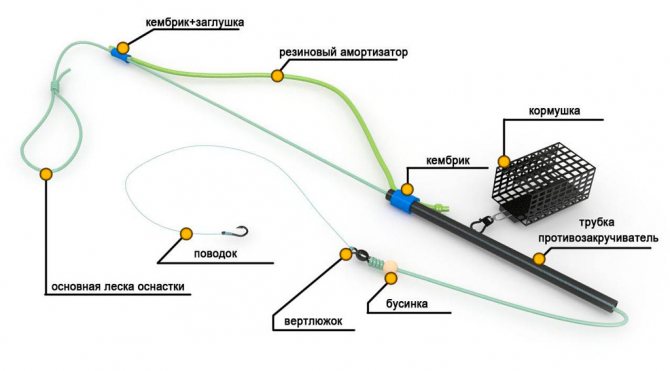
The equipment is striking in its variety of shapes, sizes and arrangement methods, but still the choice of each specific model depends on the type of fishing and the expected catch.
Thank you for fishing with us! Or not yet? Yandex.Zen Facebook
Tags
for a spinning fishing rod
The main difference between spinning and casting
There are several signs to understand the difference between a casting rod and a spinning rod. For example, the diameter of the passage rings is small; they are mounted on a low stand. But the number of rings has been slightly increased and they have been moved to the other side of the rod in relation to the reel. The casting form is equipped with a multiplier reel.
Multipliers are used on somewhat powerful whips, which is why by increasing the number of guide rings the rod is unloaded more evenly. The multiplier is an improved type of conventional inertia-free gear; its operation is based on the principle of a winch. The use of a multiplier reel is due to the large mass of bait when casting.
Now let’s try to consider not how a casting spinning rod differs from a regular one, but what their similarities are. Perhaps there is only one thing: spinning rods are determined by test and structure. The casting pattern is also determined by the fishing conditions. If you will be jerking with persistent baits, you will need a short and rather rigid blank.
According to the test, casting rods are divided into light, medium and heavy. What is the difference between spinning and casting - the weight range of baits is up to 200 grams. Heavier ones can also be used, which are used in sea trolling to catch large fish. However, light baits are also successfully used: wobblers and jig heads.
Experienced fishermen give many arguments in favor of casting tackle, considering the possibility of feeling a bite with the finger of the hand, which lies on the braided cord, as a significant advantage. Fishing with a multiplier is much more comfortable. The disadvantage is the inability to cast very light types of bait.
